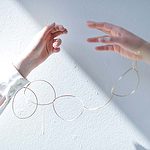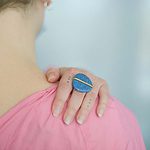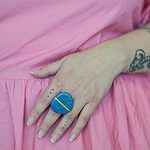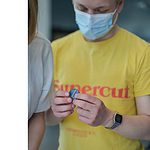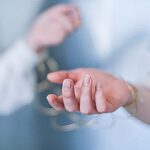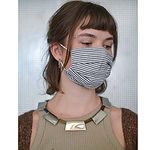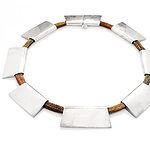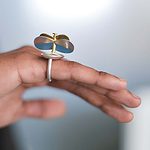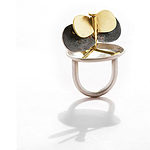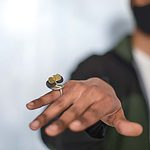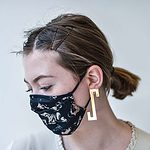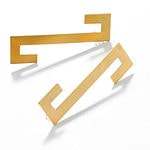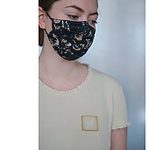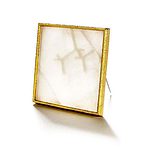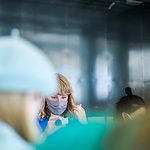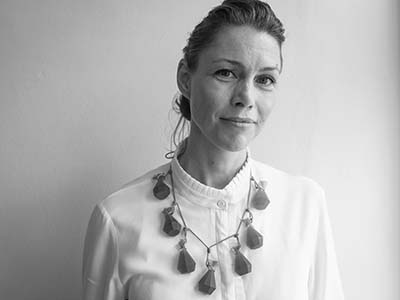In this photo essay, Anni Nørskov Mørch tells us about the Danish Arts Foundation’s Jewellery Collection, which is available for loan. Click on the photos to learn about what they show.
In fact, every Dane is invited to borrow a piece of jewelry from the collection. The loan is free of charge and insured by the Danish state. You can pick up the jewelry yourself or have it sent to your home address.
Jewelry loans are given to wearers with an active role at a public event. At the event the wearer acts as an ambassador for Danish jewelry in general and the borrowed piece in particular.
The collection consists of more than 300 pieces: rings, bracelets, brooches, necklaces, hairpins, earrings, a few belts, watches, and cufflinks … and a single tiara with beetle wings.
Since 1978 the Foundation has bought new pieces directly from Danish artists and designers. Acquisitions are guided by the criteria of artistic quality and talent. The result is the largest public collection of Danish contemporary jewelry. And the collection is still growing.
The collection promotes Danish contemporary jewelry via loans and exhibitions in Denmark and abroad. In 2019 the Danish Crown Princess Mary opened the exhibition Statecraft, which showed more than 90 pieces at the Houston Center for Contemporary Craft. In 2020–2021 two exhibitions were shown in Germany. First a selection of 78 pieces of jewelry were shown at the State Collections of Antiquities in Munich; then almost 150 pieces at MAKK – Museum of Applied Arts Cologne.[i] In Denmark the collection has been on view in long-term exhibitions at Design Museum Denmark and The Museum at Koldinghus (now Museum Kolding), and selected pieces have been loaned to special exhibitions.
The Foundation of the Collection
The Danish Arts Foundation is the largest arts foundation in Denmark. It aims to spread the arts to a wide audience all over Denmark, to promote Danish art internationally, and to pave the way for talented artists.
The activities of the foundation are funded by the Danish State but governed by the principle of “full arm’s length” between the artistic and political levels. Artwork like paintings and sculptures are also bought by the Foundation, loaned out, and eventually donated to public institutions to give the Danish public access to art of the highest quality.
To meet the same goal, the jewelry collection has been accessible for use at official events via the loan scheme since 2007. In this way the Foundation makes its jewelry collection available to the public the same way paintings and sculptures are bought and donated to schools and museums.
However, jewelry is less impactful on a wall—and demands security measures. Therefore, the jewelry loan scheme is tailored to the body-related scale of jewelry and to its ability to work as a conversation starter in social settings.
There is also another important distinction between the jewelry collection and the rest of the acquisitions made by the Danish Arts Foundation: All pieces of jewelry remain owned by the Foundation, which makes the jewelry purchases a collection. To be more precise, it is a collection of both jewelry and the stories accumulated with every use. User stories like that are a rare feature in a public collection—and a trove of inspiration for a museum practitioner like me.
Collecting stories
The reasons for my interest in the Danish Arts Collection are manifold, and I have had several touchpoints with the collection.
In 2018 I curated the exhibition The Splendour of Power, at the Museum at Koldinghus (today Museum Kolding). It spanned 750 years of history, and Josephine Winther’s collier Rubyfruits (2003), from the Danish Arts Foundation’s Collection, was on loan to illustrate the values of trust and democracy in today’s Danish society.
In 2019 the Danish Arts Foundation’s entire collection was moved to be housed at, and the loan scheme administered by, the Museum at Koldinghus. As Head of Exhibitions, I then curated the museum’s first exhibition of the collection in its entirety.
During my work with the collection, it became apparent to me how the loan scheme highlights and challenges conventions. A public collection is conventionally only accessible through the mediation of professionals or display cases. And the intimate experience of wearing a handpicked accessory and perhaps using it as a conversation starter at a social event is normally an experience limited to one’s private—and more modest—collection.
This made me curious to know more about the borrowers’ experience and how these experiences might impact the collection. In a research project, supervised by Professor Eva Brandt, at Design School Kolding, in 2021, I had the opportunity to ask some of these questions:
- What informs the choice of a piece of jewelry for a loan and what impression does the use of a loaned piece of jewelry make on the wearer and viewer?
- What experience-based knowledge might be generated with use and how might this inform the development of a public collection?
Jewelry salons
To attempt to answer these questions, I partnered with jewelry artist and teacher at Design School Kolding, Josephine Winther, and a group of her students. We met online and in person in two jewelry salons.
I introduced the students from the Accessory Design and the Industrial Design study programs to the collection and the loan scheme. Afterward they had the opportunity to interact with a selection of pieces from the collection and reflect on their roles as wearers and makers.
Photographer Katrine Worsøe captured the interactions, and in this photo essay her photos are displayed along with student reactions and insights from the jewelry salons.
The jewelry was handled without gloves, because although this is a public collection, it is one that is in use. We all wore masks, though, due to restrictions to limit the spread of the COVID-19 virus. All in all, the jewelry salons provided an intense setting for a lively talk about jewelry as something to collect, something to wear, something to make, and something to talk about.
My three most distinct takeaways from my interviews with the students and a follow-up questionnaire were:
- Touching the pieces and wearing them in a social setting made the unique qualities of the artworks more accessible, according to the participants.
- Beyond the information made available through interacting with the pieces, the participants were very curious to know more about the previous wearers and the maker. These stories are only available if records are kept.
- As design students, the participants used the jewelry salons to reflect on their identity as designers. They showed a keen sensibility for the match between accessories and identity. That made them alert wearers and curators.
These three insights might inspire the Danish Arts Foundation and other publics collections to find ways
- To put more objects within reach.
- To keep records of user’s interpretations of objects.
- And to make available more study collections and to include more diverse curatorial voices.
For my part, the design students’ reactions fueled my curiosity and further research into the user and designer perspectives on the Danish Arts Foundation’s Jewellery Collection.
[i] Liesbeth den Besten wrote about these exhibitions for AJF. Read the article here.
